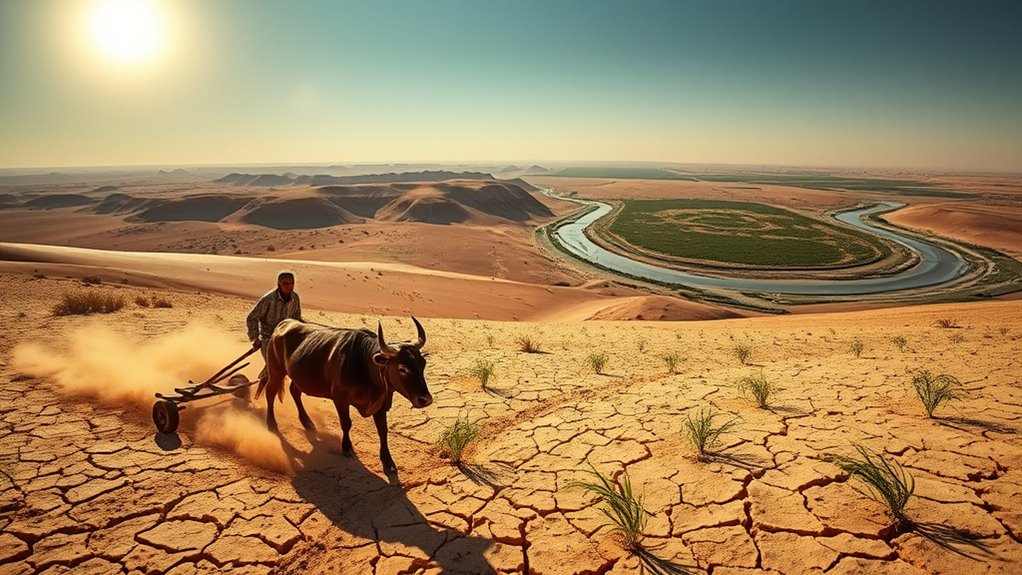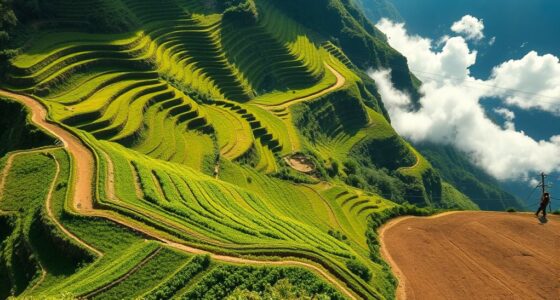Farming in Mesopotamia posed numerous challenges due to unpredictable rainfall, saline soils, and flooding during the rainy season that could wipe out crops. You relied heavily on complex irrigation systems, which were vital yet susceptible to salinization and erosion. Additionally, limited fertile land meant careful crop selection was crucial for survival, with barley and date palms favored. These factors interplayed intricately, influencing not just agriculture but the economy as a whole, and there's more to discover about this fascinating topic.
Key Takeaways
- Unpredictable rainfall patterns led to unreliable agricultural yields, complicating farming efforts in Mesopotamia.
- Thin, saline soils required careful crop selection and management to sustain agricultural productivity.
- Dependence on irrigation systems made crops vulnerable to salinization, threatening soil fertility and farming viability.
- Frequent flooding during the rainy season could completely destroy harvests, impacting food supply and economic stability.
- Erosion and the harsh climate created ongoing challenges for maintaining soil health and agricultural output.
Climate Challenges in Mesopotamia
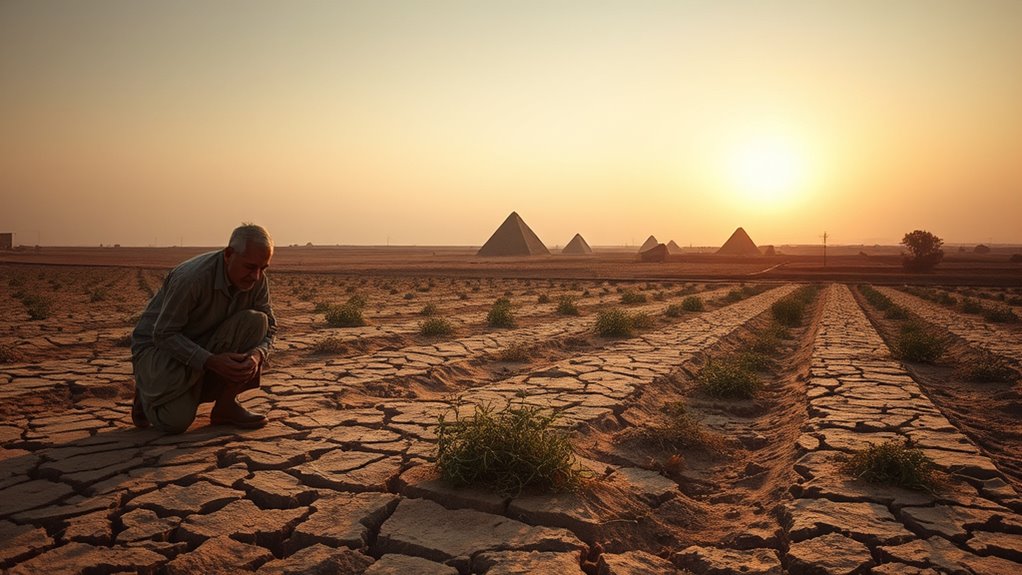
While Mesopotamia's climate offered distinct seasons, it also posed significant challenges for farmers. You faced unpredictable rainfall patterns, making agriculture unreliable without effective irrigation.
The region's thin, saline soils further complicated crop growth, especially during periods of drought and cooling, like around 6400 B.C. Flooding during the rainy season could destroy entire harvests, leaving you vulnerable.
Thin, saline soils and unpredictable floods made farming in Mesopotamia a constant struggle for survival and resilience.
Adapting to these harsh conditions became essential; you turned to resilient crops such as barley and date palms. By managing irrigation effectively and employing techniques like crop rotation, you aimed to maintain soil fertility. Additionally, the use of effective irrigation techniques was vital for maximizing crop yields and ensuring sustainability.
Navigating these climate challenges required ingenuity, which shaped your agricultural practices and ultimately influenced the broader society in Mesopotamia.
Dependence on Irrigation Systems

As you navigated the challenges of agriculture in Mesopotamia, the dependence on irrigation systems became a lifeline for your farming endeavors.
You relied on a sophisticated network of canals, dams, and reservoirs to manage water flow and prevent floods. These systems allowed you to cultivate crops in areas that would otherwise be unsuitable, boosting food production.
With advanced engineering, you adapted shadufs to lift water for fields farther from rivers. However, maintaining these systems was crucial; regular repairs were necessary to avoid disruptions.
While irrigation supported urbanization by providing surplus food, it also posed challenges like salinization that threatened your soil's fertility.
Despite these obstacles, your reliance on irrigation underscored its importance in Mesopotamian agriculture.
Soil Quality and Agricultural Viability
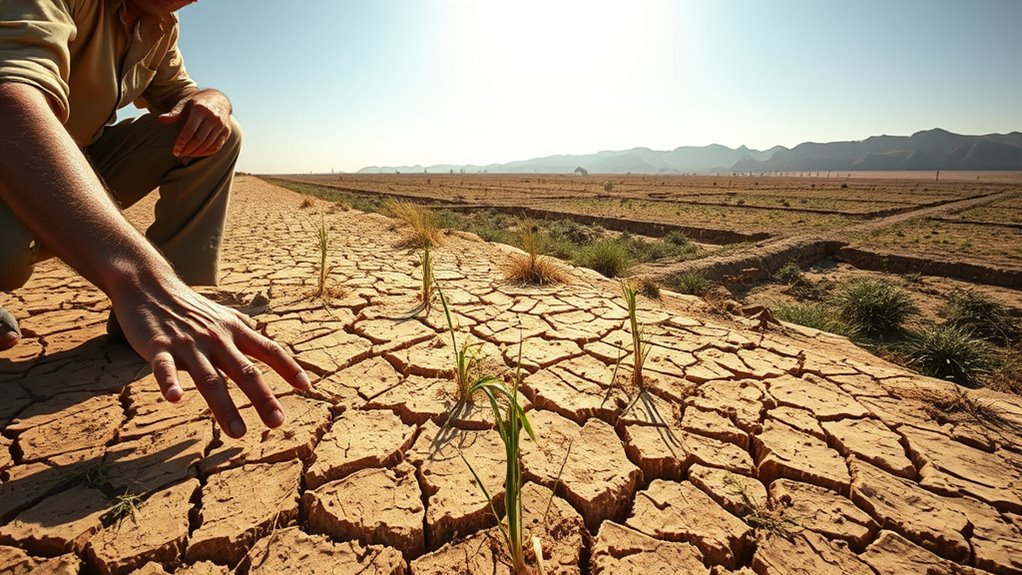
The success of agriculture in Mesopotamia hinged not only on sophisticated irrigation systems but also on the quality of the soil. You'd find that the region's soil was often shallow, composed of limestone or gypsum, which limited its fertility.
Irrigation, while essential, accelerated salinization, making crop growth challenging. Erosion posed another risk, particularly in arid areas, further diminishing agricultural viability.
Fertility varied greatly, with northern regions proving more productive than the south. Climate conditions, including extreme temperatures and unpredictable flooding, only heightened these issues.
Farmers implemented practices like crop rotation and leaving land fallow to manage soil health. However, soil degradation ultimately led to reduced agricultural output, affecting food security and societal stability.
Crop Selection for Harsh Conditions
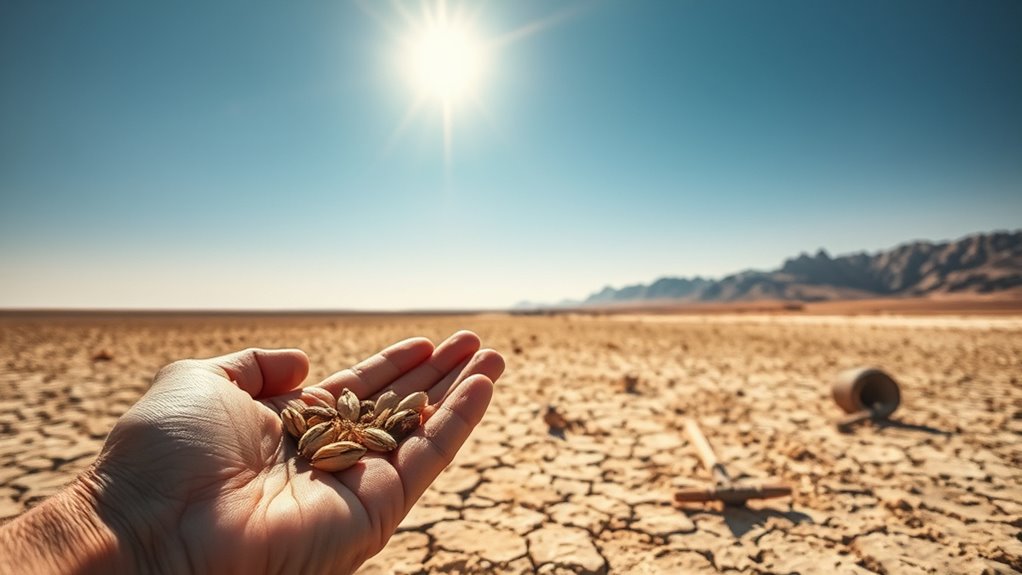
To thrive in the challenging conditions of Mesopotamia, farmers had to make strategic choices about their crops. Barley became a staple due to its salt tolerance, thriving in the region's saline soils.
While wheat and emmer were less resilient, they served luxury needs, especially for beer. Farmers also grew millet and other grains, but barley dominated.
Date palms flourished in high temperatures, providing essential sugars and vitamins. Legumes and vegetables like peas, lentils, onions, and cucumbers rounded out their selections, often planted in the shade of date palms to shield them from the harsh sun.
Economic Factors Influencing Farming
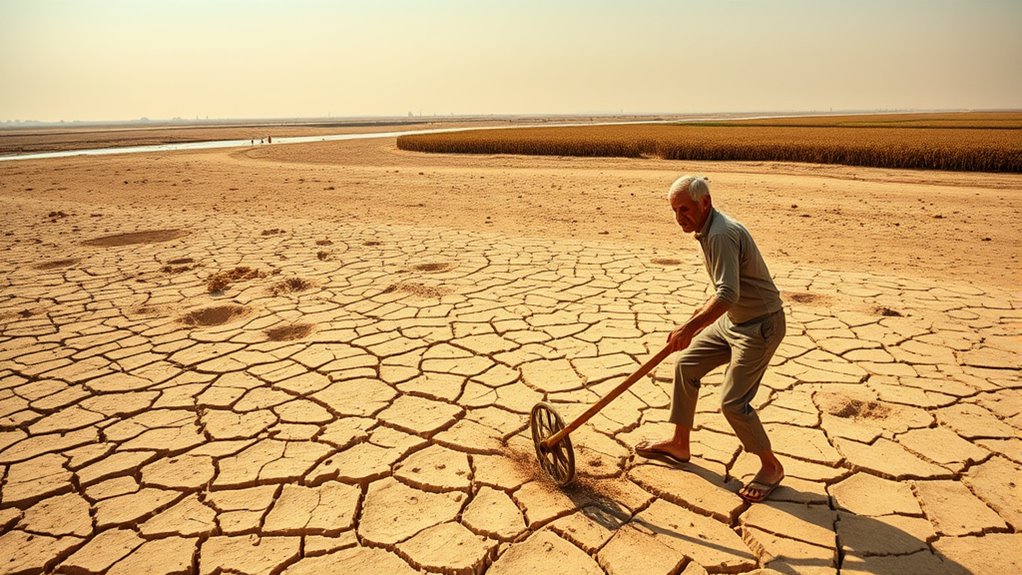
Farming in Mesopotamia wasn't just about choosing the right crops; it also involved navigating a complex web of economic factors.
Farming in Mesopotamia required not only crop selection but also careful navigation of economic complexities.
You faced challenges like a lack of natural resources, forcing you to rely on trade for essentials like food and materials. Bartering and using commodities like barley as currency shaped your transactions.
Labor specialization emerged, with many workers paid in barley, while slaves captured during wars contributed to agricultural output. Trade routes influenced production, but fluctuations could threaten your financial stability.
Institutions provided oversight and support, but high interest rates from barley bankers posed risks.
Ultimately, agriculture was vital, sustaining economies and empires, yet it depended on these intricate economic dynamics.
Technological Innovations in Agriculture

While navigating the challenges of agriculture in Mesopotamia, you relied heavily on various technological innovations that transformed farming practices.
Early irrigation systems, like shadufs, allowed you to siphon water from rivers, while advanced canal networks ensured a steady water supply.
You used wooden plows, evolving over time, to efficiently sow seeds. Crop management techniques, such as rotation and fallowing, kept your soil fertile.
Simple tools like sickles and threshing paddles aided in harvesting. Additionally, animal husbandry provided essential resources like milk and wool.
These innovations not only increased productivity but also supported the growth of settlements and enabled specialization in other industries, laying the groundwork for a thriving agricultural society.
Societal Impacts of Agricultural Practices
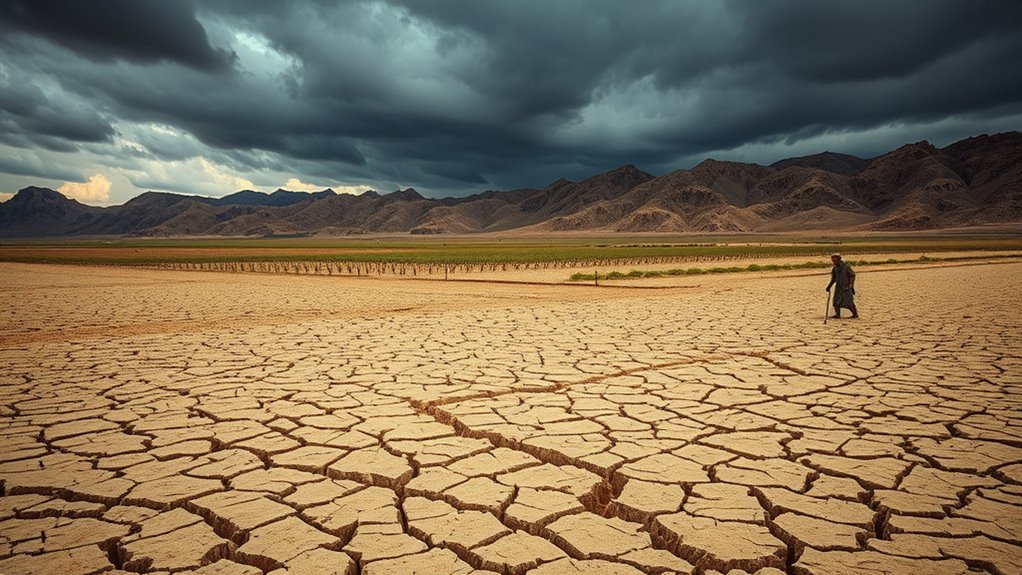
As agricultural practices evolved in Mesopotamia, they significantly shaped societal structures, leading to the rise of complex communities and distinct social hierarchies.
The agricultural surplus allowed cities to flourish, supporting non-farming populations and facilitating trade. With farmers forming the largest class, their role became essential in providing food and raw materials, while the upper class, including kings and priests, controlled resources and power.
The agricultural surplus was vital for city growth, enabling trade and establishing a clear social hierarchy among classes.
This hierarchy reinforced social stratification, limiting opportunities for the lower class. However, some avenues for social mobility existed, often through economic success.
The abundance from agriculture also spurred cultural achievements, intertwining with religious practices and community life, ultimately defining Mesopotamian society's character and dynamics.
Management of Environmental Risks

Effective management of environmental risks was crucial for the survival of agricultural communities in Mesopotamia. You'd have to navigate challenges like climate variability, ensuring water availability through extensive canal networks and regular maintenance.
Soil conditions tested your farming skills, with salinization forcing you to adopt crop rotation and leave fields fallow to restore fertility. Renewable energy sources such as solar power could have provided sustainable solutions for irrigation challenges. Desertification from overgrazing worsened soil degradation, demanding innovative solutions.
You faced locust infestations that threatened your crops, requiring methods like drowning larvae with canal water. Utilizing technological innovations, such as the ard plow and irrigation systems, helped optimize your farming efficiency. Additionally, solar-powered irrigation systems could have enhanced crop yields and efficiency, providing a modern solution to some of the challenges faced in ancient farming practices.
Frequently Asked Questions
What Were the Major Crops Cultivated in Ancient Mesopotamia?
In ancient Mesopotamia, you'd find major crops like barley, the staple grain for food and trade.
Wheat was also popular, mainly for luxury items and beer.
You'd see date palms providing sweet fruits and palmwood, while sesame and flax played roles in oil production and linen, respectively.
Each crop had its place in daily life, contributing to the economy and diet, shaping the culture around you in significant ways.
How Did Mesopotamian Farmers Manage Water Scarcity?
Water scarcity's a relentless adversary for Mesopotamian farmers.
To tackle it, you'd harness innovative irrigation systems, digging canals and building dams to channel river water effectively. You'd also rely on seasonal flooding, storing excess water in basins for dry spells.
Crop rotation and soil management techniques would help combat salinization, ensuring your fields remain fertile.
With diligence and creativity, you'd transform challenges into opportunities, nurturing a thriving agricultural landscape.
What Role Did Livestock Play in Mesopotamian Agriculture?
In Mesopotamian agriculture, livestock played a vital role.
You'd rely on cattle for ploughing fields and transporting goods, while sheep provided wool, meat, and milk.
Goats offered fleece and hair, essential for textiles.
With transhumance practices, you'd move herds to better pastures, ensuring their health.
Additionally, livestock served as a form of wealth, influencing trade and economic stability, making them integral to your farming success and daily life.
How Did Trade Influence Agricultural Practices in Mesopotamia?
Imagine you're in ancient Mesopotamia, where trade flourishes and your crops are key to success.
Trade influences your agricultural practices significantly; you grow barley for its salt tolerance and wheat for luxury goods. As you exchange grain and textiles with neighboring regions, you adapt your crop selection based on market demand.
This not only diversifies your harvest but also drives innovations in irrigation, helping you maximize output and thrive economically.
What Were the Consequences of Salinization on Farming?
Salinization significantly impacts your farming efforts. It reduces soil fertility, leading to lower crop yields and less agricultural productivity.
Over time, you may find your fields becoming unusable, forcing you to abandon them. This decline directly affects your economic stability and the local community.
You might need to switch to salt-tolerant crops, but that won't fully mitigate the repercussions. Ultimately, salinization disrupts both your farming practices and the broader agricultural landscape.
Conclusion
In conclusion, farming in ancient Mesopotamia was no walk in the park. You faced daunting climate challenges and had to rely on complex irrigation systems to thrive. Interestingly, some scholars argue that these struggles spurred technological innovations that advanced agricultural practices. This resilience not only shaped the economy but also influenced societal structures. By understanding these challenges, you can appreciate how Mesopotamian farmers laid the groundwork for future civilizations, turning adversity into opportunity.

